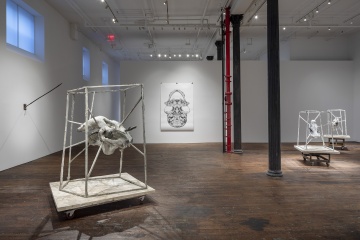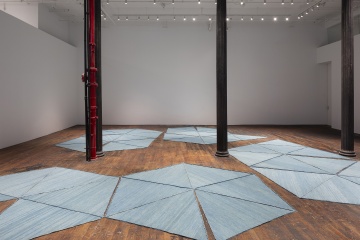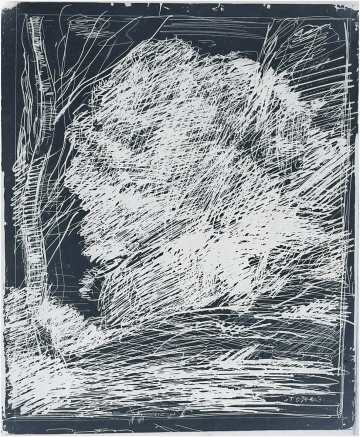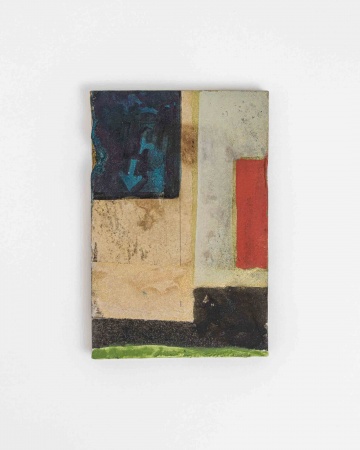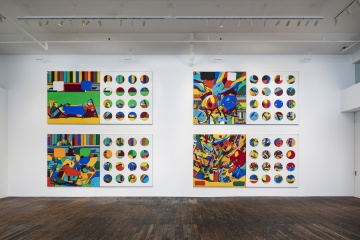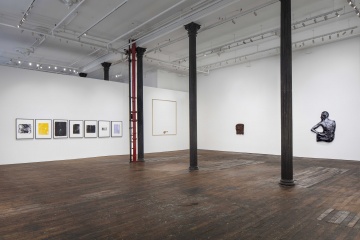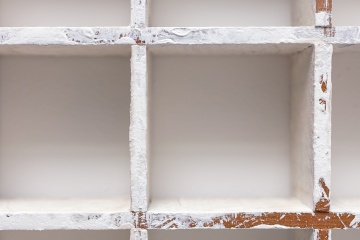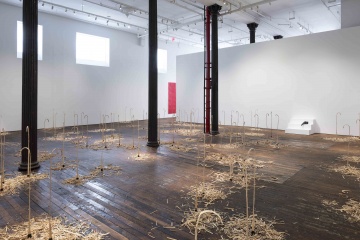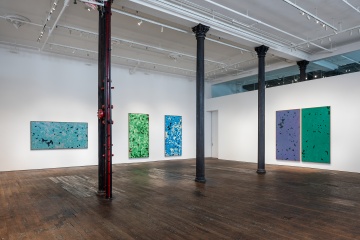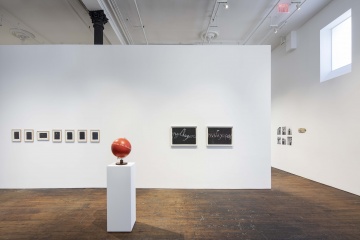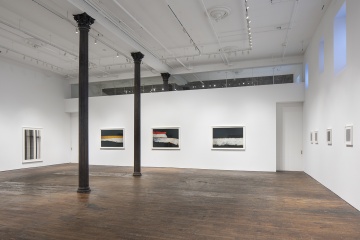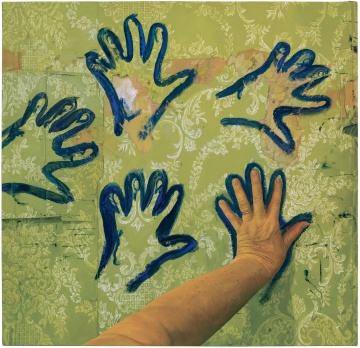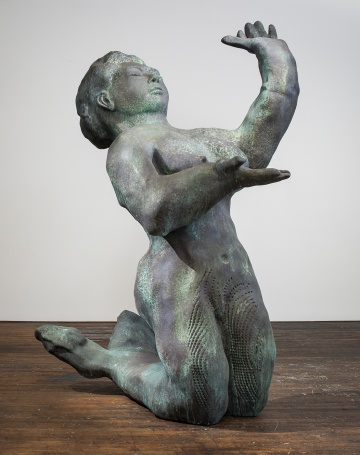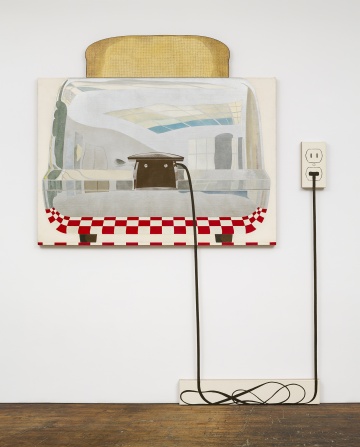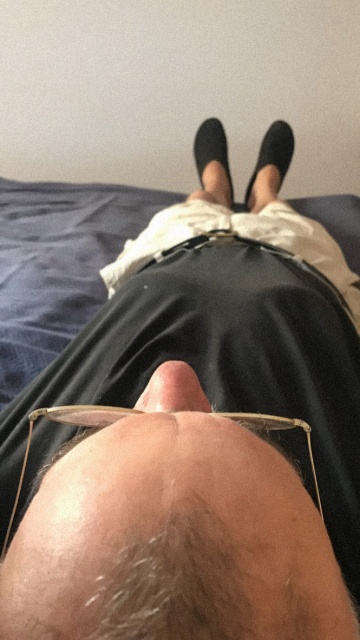Peter Freeman, Inc.
140 Grand Street
New York, NY 10013
212 966 5154
New York, NY 10013
212 966 5154
Peter Freeman, Inc., founded in 1990, represents leading international artists and estates of several generations and specializes in important paintings, sculptures, and drawings of the 19th, 20th, and 21st centuries, with a particular emphasis on early Pop, Minimal, and Conceptual works.
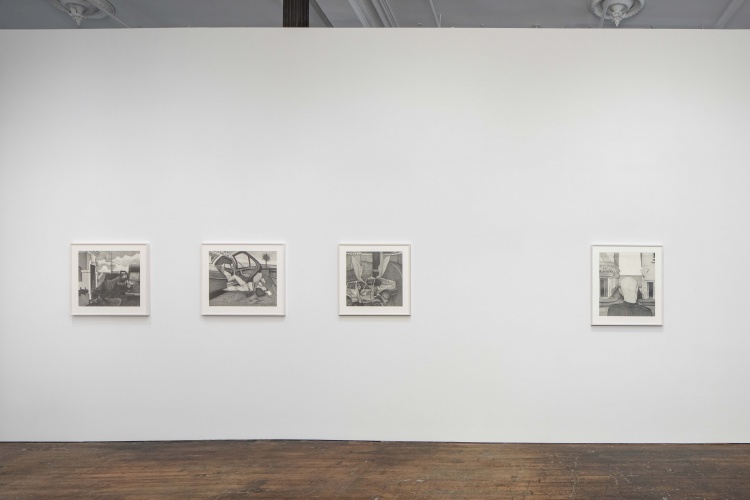

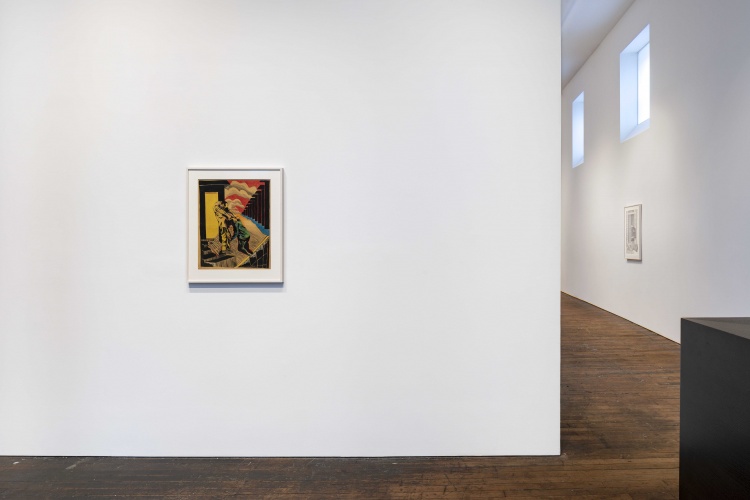
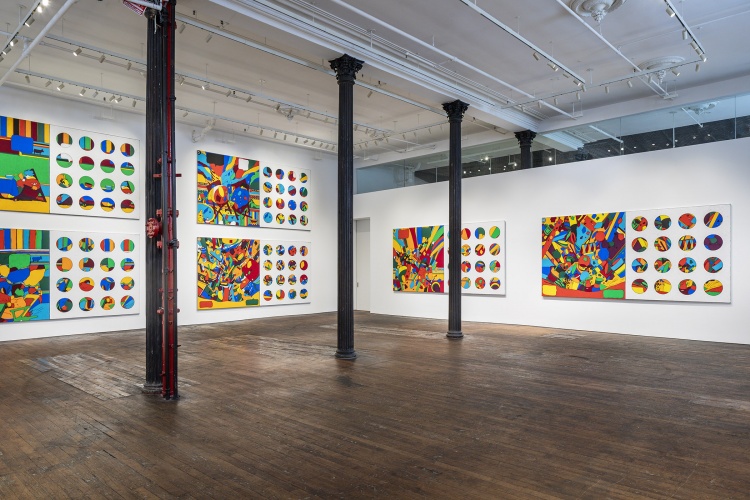

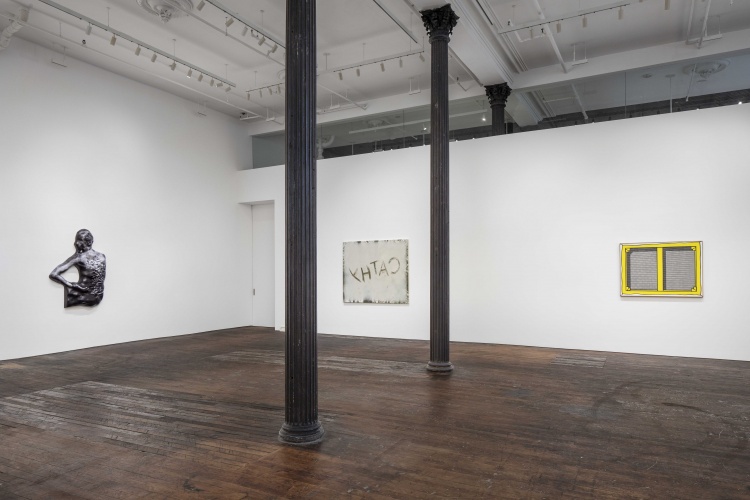
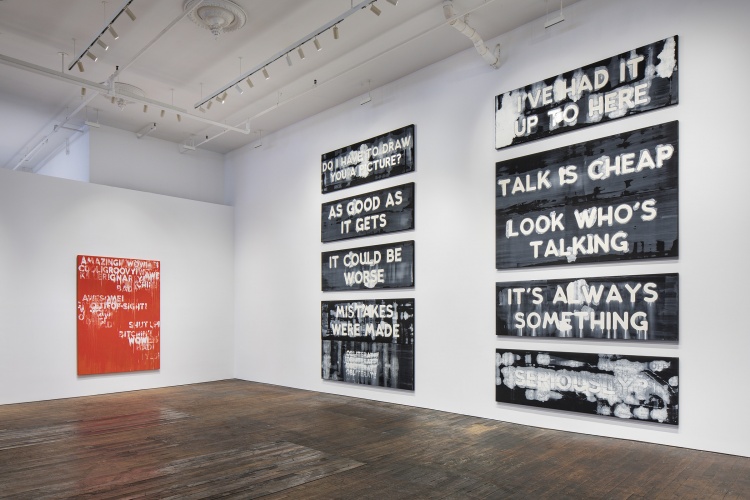



Paul Anthony Harford | Paul Anthony Harford: The Circus Animals' Desertion
BACK | David Adamo Alvin Baltrop Elisabetta Benassi Arthur Jafa Roy Lichtenstein Adam McEwen Catherine Murphy Bruce Nauman
Paul Anthony Harford | Paul Anthony Harford: The Circus Animals' Desertion
Matt Mullican | Sunday, August 9, 1908
Courtesy of Peter Freeman, Inc.
BACK | David Adamo Alvin Baltrop Elisabetta Benassi Arthur Jafa Roy Lichtenstein Adam McEwen Catherine Murphy Bruce Nauman
Mel Bochner | MEL BOCHNER SELDOM OR NEVER SEEN 2004–2022
Mel Bochner | MEL BOCHNER SELDOM OR NEVER SEEN 2004–2022
Fernanda Gomes | Fernanda Gomes
Fernanda Gomes | Fernanda Gomes

Richard Wentworth
April 18, 2024 - May 31, 2024

Robert Moskowitz
March 14, 2024 - May 16, 2024
Charles LeDray
Shiner
November 2, 2023 - January 6, 2024
Peter Freeman, Inc. is pleased to present American artist Charles LeDray’s second solo exhibition with the gallery, comprised of nine new sculptures and drawings made in New York, primarily over the last three years.
Shiner
S.A.M.
Spool’n: How My Mother’s Embroidered Apron Unfolds in My Life*
Revolution
Men Man Woman Women
Backward Suit
Hope Chest
Cone Cube Sphere
Briefs
How Long Should Memories Last?
Charles LeDray uses a multitude of techniques including carving, casting, drawing, painting, printmaking, sewing, and throwing. The artist recreates existing objects, transforming them through uncanny manipulations of scale and re-combinations that suggest narratives about history and society.
Here, containers – from pockets, to pallets, cigar boxes, chests, and vitrines – hold collections of individualized yet related objects: things we amass to remember, or to project who we are, where we have been, need, or want to go.
Born in Seattle in 1960, Charles LeDray moved to New York in 1989 and has exhibited regularly since 1991.
LeDray’s work is in numerous public collections including The Museum of Modern Art; Whitney Museum of American Art; The Metropolitan Museum of Art; San Francisco Museum of Modern Art; Museum of Art; and Smithsonian Museum of American Art.
An annotated exhibition checklist will be available. For all media-related requests, please contact the gallery: +1 212 966 5154 or anna@peterfreemaninc.com.
*Arshile Gorky, How My Mother’s Embroidered Apron Unfolds in My Life, 1944, oil on canvas, 40 x 45 inches (101.6 x 114.5 cm). Collection Seattle Art Museum.
Helen Mirra
green holotrope
September 9, 2023 - October 28, 2023
For green holotrope, Helen Mirra shares a selection of new and revised works. Explicit in the project is a possible answer to the existential question of how to meet things. Objects, sounds, and methods fold and realign; prior works get edited, put into new arrangements, or remade with a method of subtraction that sometimes looks like addition. Here, a compelling case is made that less is not more, nor is it less. When works and thoughts return, it is in the visible cycles of their repetition, and the space generated between occurrences, where we might find patterns for holding future and past equally within the present. For example, a new series of canvases revise a number of earlier signature line works. Resetting the delicate and precarious banding of the prior works onto linen rectangles condenses the initial experiences for more compact and pliable consideration. The 2005 sound piece Green break, with its three methods of amplifying the breath (whistling, bass harmonica, and mouth harp) rearranged, is not unlike a bird adapting its song for a changing ecological niche.
Four segments from Sky-wreck, unseen in the United States since their initial presentation at the Renaissance Society at the University of Chicago in 2001, are indigo-dyed cotton scale model pieces of the sky, if the sky was a
geodesic dome. Twenty-two years ago the sculpture in its larger iteration was interpreted as an abstractly elegiac gesture. Reappearing today, the fractured expanses of soft geometry seem to act as a harbinger of our biosphere’s collapse that more of us can hear.
For Helen Mirra, who wrote a manifesto of sorts in 2019 to address environmental concerns relative to received artmaking and exhibition practices, revisiting and remaking past works is an obvious move. Attending to things as artifacts of change keeps decisions and methods close at hand. This looking again and anew and again at the works
assembled for green holotrope reveals an effortless focus on the primacy of gravity and the intrinsic qualities of unrefined materials, relative scales, and simple structures. The objects philosophically bounce and physically echo, vibrate, turn, weather, and open as material integrity allows. The foreground and background flip and flap. Because
really, what is the difference between the hole in a donut and the hole in a bagel?
Helen Mirra has been represented by Peter Freeman, Inc. since 2004. She lives in West Marin, Northern California. Her work Harmless mistake is currently on view in Spora, at Swiss Institute, New York.
Dove Allouche, Mel Bochner, Mohamed Bourouissa, Jean-Baptiste-Camille Corot, Tacita Dean, Jan Dibbets, Seth Price, Thomas Ruff
Misunderstandings
June 8, 2023 - July 29, 2023
Peter Freeman, Inc. is pleased to present Misunderstandings, a group exhibition curated by Erik Verhagen, that explores the paradoxical nature of photography, its physical and indexical qualities that link it to reality, and its constructive potential, so amenable to cross-fertilization and manipulation. The title, borrowed from Mel Bochner’s Misunderstandings: A Theory of Photography (1970), highlights the ambiguous nature of photography, its capacity to be informed and also deformed by the historical and sociological tensions inherent to image (re)production.
Ernst Caramelle
actual size
April 20, 2023 - May 27, 2023
Peter Freeman, Inc. is pleased to present Ernst Caramelle: actual size, the artist’s fourth solo exhibition with the gallery and his second at this New York location.
Austrian conceptualist Caramelle regularly engages wall painting, drawing, photography, video, publishing, and interventions with architecture. This exhibition features a generous selection of his works on paper and board spanning decades, alongside publications and a video. Regardless of his choice of materials, Caramelle’s concerns
remain consistent: production, or keeping things going; reproduction, or transforming things through duplicating and publishing; and perception, or finding the most improbable things through direct observation.
Formally trained as a glass painter, Caramelle’s work across all media is characterized by a lightness of touch and humorous play with scale, flatness, and depth. Whether it is in the speediness of a wine spill forming a landscape or the slow burn of the sun blanching the colors of construction papers, he guides his forms into focus. Given his openness to processes that are only moderately controllable, the studio is a constant and crucial space for keeping transformations manageable and ongoing. As a site for daily routine, with the day-to-day doodles, the focused planning, small accidents, and sudden miracles accumulating, even his studio table tops become works.
The proposition in the title, actual size, allows Caramelle’s use of marginalia and framing devices as tools to open an elastic relationship between abstraction and illusion—after all, how can a thing be anything but its own actual
size? This is a gesture reaching across decades to previous Caramelle projects. For example two publications from 1990, the catalogue Panorama der Retrospektiven (Rainer Verlag) and the artist’s book Grandeur nature (Musée d’Art Moderne de la Ville de Paris), each feature basic geometric forms paired with labels to identify them as precise objects or spaces, playing the actual size of the images off the imagined scale of their identifications.
Ernst Caramelle sets in motion a steady approach to making and observing. Even when keeping things to their actual size, the artist’s oeuvre is an ode to the process: shifting perception and form by keeping open to changes of direction.
Ernst Caramelle (b. 1952, Tyrol, Austria) lives and works in Frankfurt and New York. Notable solo exhibitions include Museum moderner Kunst Siftung Ludwig, Vienna (2018); Bonnefanten Museum, Maastricht (2016); La Salle de Bains, Lyon (2014); Wexner Center for the Arts, Columbus (2012); Bloomberg Space, London (2010); Galerie im Taxispalais, Innsbruck, Austria (2008); Museu Fundação Serralves, Porto, Portugal (2005); the National Gallery, Berlin (1990); the Kunsthalle Bern (1986); Portikus, Frankfurt; and Wiener Secession, Vienna (1993). Group exhibitions include the Kunstmuseum Stuttgart (2020); MIT List Art Center, Cambridge (2018); Städtische Galerie, Karlsruhe (2015); South London Gallery (2010); Sammlung Generali Foundation, Vienna (2005); Documenta IX, Kassel (1992); and Musée d’Arte Moderne de la Ville de Paris (1990).
A reception with the artist will be held on Thursday, 20 April, 6-8pm. Caramelle will give a talk and walkthrough of the exhibition on Saturday, 22 April at 4:30pm.
Matt Mullican
Matt Mullican Sunday, August 9, 1908
March 2, 2023 - April 15, 2023
Sunday, August 9, 1908
Is the title of my exhibition at Peter Freeman opening on
Thursday, March 2, 2023
I have been using comic images in my work since 1973. I was interested in the details of the comic image and I cut out parts of comic books depicting the physical elements of water, air, gravity, food, light, beds, cars, shadows, etc.
I was interested in depicting
The parts of that world that
Support life in the pictured world.
This became
Details from an Imaginary Universe.
I was interested in entering the picture.
Also in 1973 I was experimenting with light patterns and light sources.
The differences between the light patterns as perceived in comics and real life seemed arbitrary.
If all I see are light patterns where is life within those patterns?
Little Nemo in Slumberland was in the New York Herald on Sundays from Oct 15, 1905 – July 23, 1911 by Winsor McCay
Nemo’s world was in his dreams and at the end of every page Nemo would wake up, mostly by falling out of bed.
The page that my show depicts is from August 9, 1908.
There are 12 frames in the story
It starts with an invitation to have breakfast. Nemo and his friend are served by Nemo’s mother (in Slumberland). A kind of oatmeal was served and Nemo and Flip noticed that they were getting fatter and heavier!!
The more they eat the heavier they get! Next the furniture collapses! And pretty soon they are falling thru the floors of the house.
The entire picture plane is collapsing falling apart, becoming abstract, deconstructing!! This is in 1908!! Cubism, abstraction and fauvism all happening far away from the Sunday funnies in the USA. Also all of this deconstruction was happening in a dream!!
So pointing towards surrealism!
I’ve added two elements to each frame.
1st
16 circular details of each picture in exactly the same location as in the big picture.
2nd
I changed the color in every outlined area creating an abstract pattern. This relates to the idea of
“All I see are light patterns”
Both the details and light patterns refer to aspects of the work going back 50 years!
Thus making this show a kind of an anniversary.
Happy birthday, Glenn!
– Matt Mullican, 2023
Peter Freeman, Inc. is pleased to present Matt Mullican’s fifth solo show with the gallery, his third in New York in addition to two previous shows at our Paris location, featuring a new series of paintings and drawings.
Matt Mullican (born 1951, Santa Monica, California) earned his BFA from the California Institute of the Arts in Los Angeles in 1974 and has since exhibited extensively in Europe and the United States. He recently had a series of retrospective exhibitions presented by the Possehl Foundation in Lübeck and was the recipient of their 2022 Possehl Prize for International Art. Other solo exhibitions have been held at the Musée des Arts Contemporains au Grand Hornu, Belgium; de Young Museum, San Francisco; Skulpturenhalle, Neuss, Germany; Pirelli HangarBicocca, Milan; and Kunstmuseum Winterthur, Switzerland. Mullican’s work can be found in the collections of several major institutions including the Museum of Modern Art, New York; Whitney Museum of American Art, New York; Tate, London; Centre Georges Pompidou, Paris; Museo National Centro de Arte Reina Sofia, Madrid; and National Gallery of Art, Washington, DC. Matt Mullican lives and works in Berlin and New York.
For reproduction requests and press inquiries, please contact: anna@peterfreemaninc.com
Paul Anthony Harford
Paul Anthony Harford: The Circus Animals' Desertion
January 12, 2023 - February 25, 2023
Peter Freeman, Inc. is pleased to present The Circus Animals’ Desertion, an exhibition of works on paper by Paul Anthony Harford (1943–2016) selected by Cecily Brown. Originally trained as a painter, Harford drew almost every day of his life. Over the years he produced hundreds of highly finished drawings but resisted opportunities to exhibit them, remaining virtually unknown until after his death. This is the first Harford exhibition outside of the United Kingdom.
Like William Butler Yeats’s narrator in The Circus Animals’ Desertion, Harford found inspiration in the debris and “refuse” of everyday life in the sleepy coastal towns of Southend-on-Sea and Weymouth where he lived.
A mound of refuse or the sweepings of a street,
Old kettles, old bottles, and a broken can,
Old iron, old bones, old rags […]
Drawn to the permanent residents of these British seaside enclaves, many of whom were plagued with addiction
and sickness, he was fascinated by their complicated relationships with the resort towns that, on the surface, promise an escape from the larger world. His crisp, meticulous graphite drawings challenge this aspirational characterization of these otherwise declining areas, depicting a sedate world that is punctured by a sense of unease
and the uncanny.
In one drawing, a seagull flies above a man who appears to be falling into his car, his body contorted into an almost
impossible pose. Another drawing takes this even further, depicting an anonymous pair of legs essentially melting into the pavement and detached from any other identifiable body parts, while other distorted images of wrecked cars embody a similarly precarious, restless quality. And yet unexpected surrealist details, like a bed of flowers blooming from an upturned sedan or a pair of wings protruding from the top of another totaled vehicle, reveal moments of tenderness and humor within Harford’s otherwise soberly rendered scenes of mundane life.
Cecily Brown has a unique connection to the artist, who was married to her aunt when she was young. In a piece she wrote for the publication that accompanied Harford’s first solo exhibition Other Voices, Other Rooms, she refers to his drawings as an “inspirational presence” throughout her childhood. She goes on to recall the works that stand
out most in her memory, including “a figure on a tractor, elongated and torqued like an El Greco saint” and A Return of a Prodigal Son (1966), an early and unusually colorful work on paper included in her selection for The Circus Animals’ Desertion.
Born in Weston-Super-Mare in 1943, Paul Anthony Harford studied at Byam Shaw School of Art in London
before moving on a whim to Southend-on-Sea in 1963. In Southend, and later Weymouth, Harford worked at
times as a schoolmaster, cleaner, bin man, and hospital porter, all while maintaining his prolific drawing practice. His first solo exhibition, Other Voices, Other Rooms, was posthumously presented at Focal Point Gallery, Southendon-Sea, in 2018 with subsequent solo exhibitions held at Sadie Coles HQ, London, in 2018 and 2020.
David Adamo, Alvin Baltrop, Elisabetta Benassi, Arthur Jafa, Roy Lichtenstein, Adam McEwen, Catherine Murphy, Bruce Nauman
BACK
January 12, 2023 - February 25, 2023
Peter Freeman, Inc. is pleased to present Back, a selection of works from an alternative perspective, pushing into view the usually unseen, the hidden, or things thought unimportant. In this exhibition, the works offer opportunities to rethink aesthetic, formal, social, or political assumptions from new positions.
Spanning more than 50 years, from Pop art to the present, each work brings the back to the forefront, as in Roy Lichtenstein’s self-referential 1968 Stretcher Frame with Vertical Bar, a trompe l’oeil depiction of the back of the same painting. Or Bruce Nauman’s iconic Henry Moore Bound to Fail (1967/1970), cast from his own physically bound torso, which also looks back to recent art history with ironic intent.
Elisabetta Benassi’s new series prints the back sides of historic lithographic stones used by other artists. Her delicate and precise watercolors depict the back sides of archival press photos from major historical and artistic turning points, focusing on the annotated caption descriptions of the actual images which often remain out of sight. An undated 1970s photograph by Alvin Baltrop of the back of a man’s head leaves identity and the relationship to both photographer and viewer ambiguous. Baltrop’s images were often taken at the West Side Piers in Manhattan, a longtime clandestine cruising site, and routinely capture people looking elsewhere or engaged with others in a manner that draws the viewer’s attention beyond the frame of the image. In a similar gesture, Catherine Murphy paints her name written backwards on the inside of a steamed window, a message offered to someone outside the house — outside the painting.
Recent sculptural works include Adam McEwen’s CLEAN ME (2018), a pared down linear relief that draws the image of the back of a truck, and David Adamo’s untitled 2014 bronze sculpture of a stretched canvas casually leaning face to the wall — echoing the Lichtenstein nearby. Arthur Jafa’s Ex-Slave Gordon (2017), is a wall relief based on a historic photograph showing the severely scarred back of the former slave. The original photograph was circulated widely by the abolitionist movement as visual proof of slavery’s brutality. Jafa’s sculpture pushes front and center the way this history continues to resonate today despite the historical distance. The histories and references of the works in Back vary in intent, and yet form a connected circle highlighting the importance to look behind, to remember what is often out of view.
Mel Bochner
MEL BOCHNER SELDOM OR NEVER SEEN 2004-2022
November 10, 2022 - January 7, 2023
Peter Freeman, Inc., is pleased to present Mel Bochner’s ninth exhibition at the gallery. Following his recent drawings retrospective at the Art Institute of Chicago (April – August 2022), this is a survey of paintings executed on various surfaces—canvas, velvet, paper, and directly on the wall.
These text-based works pulse with a strong vein of irony and humor. Words, and phrases, spill, drip, and accumulate to the point of obliterating themselves in palimpsests of illegibility. They sit on, or recede into the substrate, they also emerge from it, as thickly pigmented forms, and three-dimensional reliefs, reenacting the current state of our national discourse.
Mel Bochner was born in Pittsburgh in 1940. He studied painting and philosophy, earned his BFA from the Carnegie Institute of Technology in 1962, and moved to New York City in 1964, where he continues to live and work. His first exhibition, in 1966 at the School of Visual Arts, Working Drawings and Other Visible Things on Paper Not Necessarily Meant to be Viewed as Art, is often cited as the first exhibition of conceptual art. In 1976, Peter Freeman, while still a student, invited him to make the cover for the Harvard University campus literary magazine. Thirty years later, in 2006, Bochner joined Peter Freeman, Inc. and has mounted eight solo exhibitions at the gallery since. Bochner has long explored the limits of language, reproduction, and repetition. Speaking to the Brooklyn Rail’s Phong Bui, at the time of his first PFI exhibition, Bochner commented on how people ‘read’ his text paintings and gave the following insight into his larger relationship with language: “a work of art lives by being continuously re-misinterpreted.”
Bochner’s work is included in many public collections around the world, including Art Institute of Chicago; Carnegie Museum of Art, Pittsburgh; The Museum of Modern Art, New York; National Gallery of Art, Washington, DC; Whitney Museum of American Art, New York; Tate, London; and Centre Pompidou, Paris. In addition to the drawing retrospective at the Art Institute of Chicago, Bochner’s recent exhibitions include a commission from his Measurement series at Dia Beacon (November 2019 – April 2021). He is currently showing a wall drawing as part of a site-specific installation series at the Menil Drawing Institute, Houston, on view until September 2023.
Fernanda Gomes
September 8, 2022 - November 5, 2022
Peter Freeman, Inc. is delighted to present Fernanda Gomes’s (b. 1960, Rio de Janeiro, Brazil) inaugural exhibition with the gallery. This is her first solo presentation since her 2019 panoramic exhibition at the Pinacoteca de São Paulo and her first one-person show in New York since 2006.
Using a vast range of materials and procedures, she makes artworks either in a traditional artisanal way or by constructing objects from all sorts of items collected from her immediate surroundings. By choosing to repurpose what already exists, she reflects on consumerism, waste, value, and the idea of economy in a broader sense, as a principle and practice.
From her first show in 1988 to her latest presentation, Fernanda Gomes treats each exhibition as a work of art in itself, creating ensembles of autonomous pieces and responding to a diversity of contexts and situations. Her work calls into question the very nature of presence, in movement, space, and time.
This exhibition features painting and sculpture, playfully stretching its limits and possibilities. It also includes a light specific ensemble—a room built to produce an even light for a group of works that exist fully in relation to the light, the space, and to each other. This is the third ensemble she has made to remain as such, each one with unique qualities. Previous iterations have been shown at the Punta della Dogana in Venice (2016), and at Galeria Luisa Strina, São Paulo (2017), recently acquired by the Museum of Modern Art, New York.
Other collections with her work include the Art Institute of Chicago; Pérez Art Museum, Miami; Vancouver Art Gallery, Canada; Centre Georges Pompidou, Paris; Museo Nacional Centro de Arte Reina Sofía, Madrid; and Tate, London. Select solo museum exhibitions include the Vienna Secession (2019); Fundación Jumex, Mexico (2018); Museu da Cidade, Lisboa, Portugal (2012); Museu de Arte Moderna do Rio de Janeiro (2011); and the Museu de Arte Contemporânea de Serralves, Porto (2006), which holds since 2009 a permanent sculpture in its park.
David Adamo
June 9, 2022 - July 22, 2022
David Adamo is an American artist (born 1979, Rochester, New York) who lives and works in Berlin, Germany. Primarily a sculptor, he engages with form and materiality, working with wood, plaster, bronze, and other materials to create installations that are both performative and formal in their arrangement.
A process of slow removal is central to Adamo’s sculpture. Objects from everyday life take on new forms, revealed by their remains: the fruit after it has been bitten, the balloon after the air has run out. The same is true of Adamo’s wood works—the eventual forms have emerged through the reduction of material.
Jan Dibbets
Billions of Universes
April 21, 2022 - June 4, 2022
For his fourth solo exhibition at Peter Freeman, Inc., Jan Dibbets presents a selection of works from his latest series Billions of Universes, shown here for the first time outside of Europe. These large-scale color digital prints demonstrate that there is no limit to image building by means of technology.
Mangelos, Julije Knifer, Július Koller, Mladen Stilinović & Goran Trbuljak
From Scratch
March 3, 2022 - April 16, 2022
curated by Branka Stipančić
From Scratch brings together five artists whose activities were associated with Zagreb and Bratislava – two especially active artistic centres – who incorporated into their work the idea that art should proceed from the basic, elemental, and essential. The exhibition emphasizes the conceptual thread in the works, created between 1949 and 2020, of Mangelos, Julije Knifer, Július Koller, Goran Trbuljak and Mladen Stilinović, in which they foregrounded their distancing from modernism, which they found insufficiently challenging, and their aspiration to find their own artistic positions. The oeuvres of Mangelos, Knifer and Koller were created along the lines of existentialist philosophy and anti-art, striving towards a conceptual practice, and Trbuljak and Stilinović followed somewhat later, when the relations in the artworld had already changed.
Mangelos's Tabula Rasa is an introduction into the exhibition in which each of the artists finds their way to symbolically "start from the beginning." For Mangelos (1921 – 1987), this means "learning the letters" of the Greek, Latin, Glagolitic and Cyrillic alphabets, runes, and others, and tying them to words. He used to explain that writing on Tabula Rasa was related to the motif of a new beginning, but also to the negation of painting. He sought to "negate the picture by writing it with words, to negate the word by painting it." He used words to redirect the process of looking towards thought and function, and away from the emotional. In the 1970s, he wrote a number of manifestos containing his propositions on art and civilization, some of which he also wrote on globes. The exhibited globe entitled Energy, flowing along the equator in different languages and scripts, is a metaphor for the world and its operating forces.
For Julije Knifer (1924 – 2004) – who, like Mangelos, was a member of the neo-avant-garde Gorgona group (active in Zagreb 1959 – 1966) – focusing on what's essential meant reducing the visual to its basic elements. He believed that by using minimal means and extreme contrasts he could achieve a form of anti-painting. He always painted the same symbol – meander – composed of black and white, vertical and horizontal lines. His work reflects boundless patience and asceticism. Repeating the same motif over and over again from the Gorgona period until his death, he proved himself to be a modern Sisyphus and his early works (1960s) are closer to existentialism than the neo-constructivism of the New Tendencies under whose auspices he started exhibiting.
Július Koller (1939 – 2007) is included in the exhibition primarily for his works featuring question marks, through which he demonstrated his artistic and political positions and his reaction to his country's socio-political instability. Koller worked in completely different circumstances than the other artists in this exhibition. Unlike Yugoslavia – which wasn't behind the Iron Curtain, which had a more moderate form of communism, where citizens could travel freely to both the East and the West, and which had embraced modernism already in the early 1950s so as to distance itself from the Soviet Union – Czechoslovakia was much more rigid in regard to artistic freedoms. Nevertheless, the neo-avant-garde appeared in exhibitions and artists's studios as early as mid-1960s. Koller, one of Slovakia's most radical artists, introduced words into his paintings, and this semantic transformation of the canvas and its conversion into text contained a compelling critique of painting. He developed the idea of "anti-happening" and "anti-painting" and wrote manifestos. He started using question marks in 1969, a year after the military had suppressed the Prague Spring. Koller would paint question marks on different materials, on everyday objects, on architecture, he would place them in different locations, and perform them in different ways in nature. For him, the question mark was a universal sign of communication, doubt and uncertainty, a symbol that examined the relationship between the individual and the collective, the relationship with the social situation, and man's relationship with the cosmos in general.
Goran Trbuljak (1948), a prominent conceptual artist, started his career with street actions in the late 1960s and went on to produce an extensive, nuanced, and intriguing oeuvre. An Artist's Exercise is a series of works which ironize and reduce to absurdity the idea of artistic skill that is necessary for creating a masterpiece. The artist exercises his eyes and hands by writing dots in school arithmetic notebooks, trying to put them right in the middle of the squares. His other "exercises" include writing straight parallel lines and the process of copying. The artist exercises as if waiting for a time when he will be ready to make his work in the future, and he's been practicing this for over forty years.
The artistic work of Mladen Stilinović (1947 – 2016) is largely concerned with the idea of the relationship between ideology and the man who resists it. Stilinović tackled some of the key linguistic, existential and artistic subjects such as work, time, money, power, and particularly pain. He saw pain as opposed to power, but also as a product of power. Like Mangelos, he liked the alphabetical order, and used the dictionary to equate the meaning of all words with the word PAIN, since "you learn the concept of pain with language" (L.Wittgenstein). The visitor is invited to play the Pain Game in which, however you throw the dice, the result is always the same. Because pain is universal. One of his films is named after a school textbook, Primer 1, 2, 3, in which he asks the audience to read aloud what they see in the film: shop signs, then to compose his poem – which had dissolved into words and letters through the frames, and to connect words and images in a fable in order to reveal the moral.
"The vocabulary" of Stilinović's works, and of the other works in this exhibition, is associated with school: reading and writing. Notebooks, books and a globe, geometric elements and rhythms, dots and lines, and the symbol of the question mark all point to learning, repetition, a pursuit of perfection, and perseverance accompanied by the hope of discovering and creating something new, of knowing how to pose the right questions and perhaps find the answers.
Despite being present on the local and, sporadically, from the early 1970s onwards, on the international art scene, their work got its due recognition only much later. Their professional careers began in the early 1990s, following socio-political changes in Eastern Europe, when an interest in artists from this region had emerged. Since then, they've regularly shown their work at numerous important exhibitions, biennials, solo and group exhibitions around the world. Gradually, they acquired a reputation, and today their works are part of world-famous museum collections such as MoMA, Centre Pompidou, MUMOK, Van Abbemuseum, Tate Modern etc.
Dove Allouche
Dove Allouche: Primordial Soup
January 13, 2022 - February 26, 2022
Peter Freeman, Inc. is pleased to present Dove Allouche: Primordial Soup, the artist’s third solo exhibition with the gallery in New York, bringing together works from three recent series: Absorption Lines (2018-2019), platinum photographic prints of the sun’s absorption lines enlarged to the point of abstraction, Repeint (2019-2021), unique Lambda prints of paint samples from Renaissance paintings, and I.R (2016-2018), more than 100 small format drawings made after Isaac Robert's glass plate photographs of the sky.
Allouche works with photographic processes, but also with drawing, printmaking, and scientific means, to bring light to natural phenomena that are otherwise invisible to the naked eye. Throughout his work, he has created a “syntax of reproducibility” (as critic Philippe-Alain Michaud has written) in which he masters and reinvents various mechanical processes, parsing them out step by step or slowing them down for examination. The means of representation become subjects in themselves, poetically intertwined with what is happening within the images.
Dove Allouche does not see making the invisible visible as a way to seek the beyond elsewhere. It is not a metaphysics but a physics of bodies that determines the relationship to objects and steers the process by which images are revealed. Applying a filter to the as yet unseeable is how he makes discoveries and adjusts the scale of visibility, to obtain a new image of something that had no prior visible appearance.
—Tristan Cormier, “Dove Allouche: making marks on a new scale” (2021), text written on the occasion of this exhibition
Dove Allouche was born in 1972 in Sarcelles, he lives and works in Paris. Recent projects include a public commission for the library of the INHA – Institut national d’histoire de l’art – in Paris, solo presentations at Le Grand Trianon, Galerie des Cotelle, Château de Versailles (May 2019), as well The Contemporary Art Gallery, Vancouver (2018), and inclusion in Préhistoire et Modernité, Centre Pompidou (Paris, May 2019). His work has previously been the subject of solo exhibitions at Fondation Ricard, (Paris, 2016), and Centre Pompidou (Paris, 2013). His work is included in several museum collections, including the Museum of Modern Art, New York, the San Francisco Museum of Modern Art, and Centre Pompidou, Paris.
An opening reception will be held on Thursday, 13 January from 6 to 8 pm.
For reproduction requests and press related questions, please contact the gallery at +1 212 966 5154 or madeline@peterfreemaninc.com.
Read the full exhibition text by Tristan Cormier below
In English: https://bit.ly/3zGUQzk
In French: https://bit.ly/3qeyF0c
Catherine Murphy
Catherine Murphy: Recent Work
November 12, 2021 - January 8, 2022
For her third solo exhibition at Peter Freeman, Inc., Catherine Murphy (b. 1946) presents thirteen recent paintings and drawings. These still-lives, landscapes, and self-portraits are all carefully witnessed or imagined scenarios, and all rely on direct observation.
As Catherine Murphy’s work embraces this close observation, it simultaneously considers the intellectual, emotional, and abstract nature of painting, and humor. Over the extended time it takes to make each work, Murphy employs a thousand instances of looking, transforming seemingly isolated and fleeting moments into representations of passing time, meditating on reality as a place of constant and inevitable change. By grounding her imagery in the everyday, she loads her representation of familiar places and objects with narrative potential.
At the same time, Murphy magnifies the tension between representation and abstraction by organizing visual information through a unique geometric lens. Forms, patterns, and grids dominate compositions and create connections between works with otherwise distinct subject matter. They are each, in their own way, studies of light, color, and reflection. The form created by two dramatically lit plastic trash bags, filled with clothes and piled on an office chair, echoes the shape of a man’s torso. A figure shrouded in a beach towel works as an interpretation of a landscape within a landscape. Her depiction of plastic buckets filled with water looks at figure, ground, and merging picture planes. Each surface reflects a distinct image of light filtering through the treetops above, while the details combine to form a single dazzling whole.
“In Catherine Murphy’s quietly beautiful paintings, the everyday tips into the transcendental”
– The New Yorker (2018)
Catherine Murphy (b. 1946, Cambridge, Massachusetts) lives and works in Poughkeepsie, New York. Following her inaugural show at Peter Freeman, Inc (2013) the gallery, in collaboration with Skira Rizzoli, published her first major monograph, written by John Yau with a foreword by Svetlana Alpers. Murphy studied at Skowhegan School of Painting and Sculpture in Maine and received a BFA from Pratt Institute in Brooklyn in 1967. She is a member of the American Academy and Institute of Arts and Letters and has work included in numerous museum collections, including the Art Institute of Chicago; The Museum of Modern Art, New York; Metropolitan Museum of Art, New York; National Portrait Gallery, Washington, DC; San Francisco Museum of Modern Art; and The Whitney Museum of American Art, New York.
Thomas Schütte
September 16, 2021 - November 6, 2021
For his sixth solo exhibition at Peter Freeman, Inc., Thomas Schütte (b. 1954) presents a selection of new sculpture, print works and drawings that investigate figurative expressiveness, scale, and material. Schütte’s latest works are being shown here for the first time outside Europe.
One of the most acclaimed artists of his generation, Schütte’s real and invented forms, often distorted and unsettling, explore themes of cultural memory, existential struggle, and human striving for an impossible utopian ideal.
Alex Hay
Past Works and Cats, 1963-2020
March 6, 2021 - May 29, 2021
Peter Freeman, Inc., is pleased to announce a retrospective of Alex Hay’s work, with new dates of 6 March – 29 May 2021. Originally planned for April 2020, what was the occasion of the artist’s 90th birthday last year, this is the artist's sixth exhibition with the gallery, and his first retrospective anywhere since the New York Cultural Center’s 1971 Alex Hay: Recorded and Performed Activities since 1962. The exhibition includes paintings, sculpture, and drawings from 1963 to 2020, with loans from the Archives of American Art, The Lowe Art Museum, Weatherspoon Art Museum, and the Whitney Museum of American Art.
Franz Erhard Walther
Migration of Forms 1956-2006
September 10, 2019 - October 26, 2019
Downtown Painting: presented by Alex Katz
June 5, 2019 - July 20, 2019
Silvia Bächli and Eric Hattan
between windows
April 16, 2019 - May 25, 2019
Charles LeDray
American Standard
February 21, 2019 - April 6, 2019
Bochner, Gober, Nauman and Serra
January 10, 2019 - February 16, 2019
Helen Mirra
Bones are spaces
November 8, 2018 - December 22, 2018
Thomas Schütte
September 13, 2018 - October 27, 2018
Summer: Curated by Ugo Rondinone
June 8, 2018 - July 27, 2018
Lucy Skaer
Sentiment
April 19, 2018 - June 2, 2018

 Back to all Member Galleries
Back to all Member Galleries

